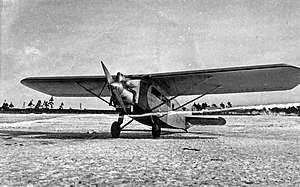PWS-20
The PWS-20 was a Polish single-engine high-wing passenger aircraft for 6 passengers, built in PWS factory in 1929, that remained a prototype. It was the first Polish passenger plane.[1]
| PWS-20 | |
|---|---|
 | |
| Role | Passenger aircraft |
| Manufacturer | PWS |
| First flight | 12 March 1929 |
| Introduction | 1929 |
| Retired | 1933 |
| Status | prototype |
| Primary user | Polish civilian aviation (LOT Polish Airlines) |
| Number built | 2 |
Development
The aircraft was developed for a contest for an airliner for LOT Polish Airlines, announced by the Polish Ministry of Communication in 1927. The best design was PWS-20, developed by Zbysław Ciołkosz. A prototype was built and flown on 12 March 1929 in Biała Podlaska. It was next bought by the Ministry of Communication for evaluation (it was also known as PWS-20T, T for transport). In 1930 the plane was modified, with wider landing gear base and improved engine's cooling and exhaust systems and passenger cabin. After modifications it was designated PWS-20bis and received markings SP-AAZ. In 1930 the second prototype of PWS-20bis was built for the same user (markings SP-AAY).
Both aircraft were tested in 1929-1931 in domestic lines of LOT, mostly for goods' transport. In a meantime however, LOT bought a party of single-engine Fokker F.VIIa/1m aircraft abroad. Performance and flight characteristics of PWS-20 were evaluated as similar to Fokker, but it was worse comparing economy of service and maintenance needs. Therefore, in 1933 one aircraft was withdrawn from use in Poznań, while the second was written off in Warsaw.
There started a construction of the third aircraft (planned SP-AAX), but it was not completed. There were some plans to complete it for a flight around the world, but they were abandoned due to financial problems. Also the designer (Zbysław Ciołkosz) planned a floatplane variant PWS-20ter for communication with Denmark and Sweden, but it was not realized.
Description (PWS-20bis)
High-wing braced monoplane of mixed construction, with closed cab and single engine. A fuselage made of duralumin (front) and steel (rear) frame, covered with canvas and duralumin in engine section. Wooden wing, with rounded endings, two-spar, plywood covered. Wooden tailfins, canvas covered. Crew of two (pilot and mechanic), in a cab before the wing, with twin controls. Next and slightly below in a fuselage, under the wing, there was a cabin for 6 passengers (dimensions: 3.15x1.54x1.8 m), with wide rectangular windows and door on the left side. Two more passengers could be carried on folding seats. The cabin had a toilet and places for 170+50 kg baggage.
W12 engine Lorraine-Dietrich LD 12Eb in the fuselage front (487 hp take-off power, 450 hp nominal power, produced by the Polish Skoda Works division). Radiator Lamblin under a fuselage. Two-blade metal propeller of a fixed pitch (3.2 m diameter). Conventional fixed landing gear, with a rear skid (main gear base 2.5 m, later 3.54 m, initially skis were used). Fuel tanks 600 l in central wing section (cruise fuel consumption 100-110 l/h).
Specifications (PWS-20bis)
Data from Polish aircraft 1893-1939[2]
General characteristics
- Crew: 2 (pilot and engineer)
- Capacity: 6-8 / 1,260 kg (2,778 lb) payload
- Length: 12.67 m (41 ft 7 in)
- Wingspan: 17.6 m (57 ft 9 in)
- Height: 3.71 m (12 ft 2 in)
- Wing area: 52.9 m2 (569 sq ft)
- Airfoil: Bobek-Zdaniewski No.4 (Göttingen 648)
- Empty weight: 1,850 kg (4,079 lb)
- Gross weight: 3,200 kg (7,055 lb)
- Fuel capacity: 800 l (210 US gal; 180 imp gal) in two wing tanks, with a supplementary 80 l (21 US gal; 18 imp gal) tank in the rear fuselage
- Powerplant: 1 × Skoda-Lorraine-Dietrich 12Eb W-12 water-cooled piston engine, 340 kW (450 hp)
- Propellers: 2-bladed fixed-pitch Duralumin propeller, 3.2 m (10 ft 6 in) diameter
Performance
- Maximum speed: 200 km/h (120 mph, 110 kn) at sea level
- Cruise speed: 160 km/h (99 mph, 86 kn) </br.
- Landing speed: 93 km/h (58 mph; 50 kn)
- Stall speed: 93 km/h (58 mph, 50 kn)
- Range: 800 km (500 mi, 430 nmi)
- Service ceiling: 3,800 m (12,500 ft)
- Rate of climb: 3.4 m/s (670 ft/min)
- Wing loading: 60.5 kg/m2 (12.4 lb/sq ft)
- Power/mass: 0.105 kW/kg (0.064 hp/lb)
References
- The second Polish passenger plane, Lublin R-IX, was flown month later
- Cynk, Jerzy B (1971). Polish aircraft 1893-1939. London: Putnam. pp. 436-440. ISBN 0-370-00085-4.
Further reading
- Andrzej Glass: "Polskie konstrukcje lotnicze 1893-1939" (Polish aviation constructions 1893-1939), WKiŁ, Warsaw 1977 (Polish language, no ISBN)
External links
| Wikimedia Commons has media related to PWS-20. |